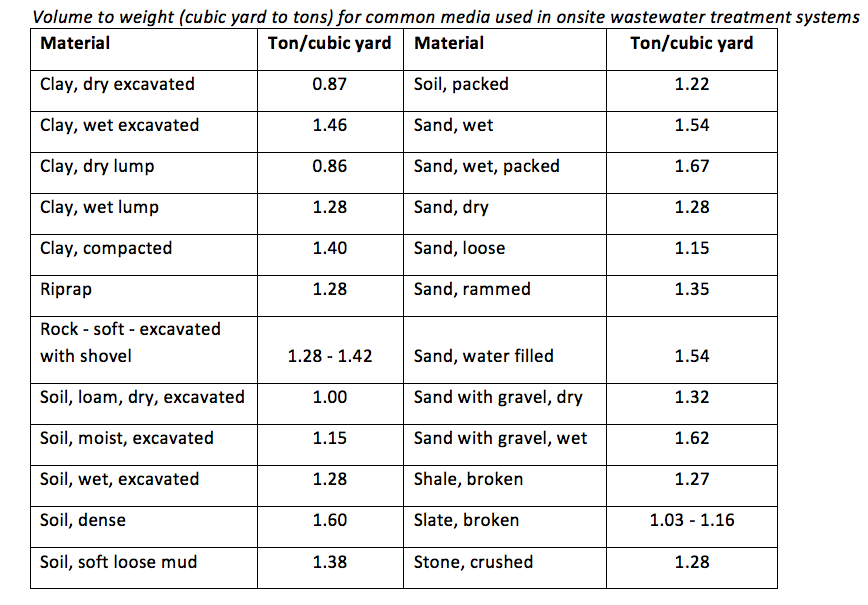By Sara Heger
It’s important to know how to properly estimate the amount of media needed on an onsite system installation job site. Excessive volumes of media result in unnecessary cost. Yet underestimating the amount of media can delay an installation.
Media is commonly bought or sold in tons or cubic yards. Installers typically purchase media in cubic yards because the system’s media requirement is based on a volume rather than a weight required. It is however important to know the weight of the media. Delivery trucks have a limited volume capacity and are also limited in the amount of weight they can carry on the road. The following is a conversion table for most media for converting cubic yards to tons.

Calculating the amount of media needed
When calculating media for a soil treatment area or for a treatment unit the method is simple. The first step is to calculate the bird’s eye view area of the container or excavation the media is going to fill. To find the volume, that area is then multiplied by the needed media depth.
It’s a good installation practice to buy a bit more media than is actually needed to account for incidentals such as storage and transport. If the installer is moving the media directly from a truck to final placement, the excess amount should be up to 5%. If the media is stored at the site before final placement, more media tends to be lost due to contact with the soil at the base of the pile. The excess amount required in this case is typically up to 10%. Depending on the material and construction method, the installer may choose to purchase even more material to compensate for over-digging. For example, sands tend to slough.
The following is an example of how to calculate the volume of stone needed for a trench soil treatment area:
A design specifies 36-inch-wide trenches, 6 inches of washed rock under the perforated pipe, and 2 inches of additional media over the pipe (total of 12 inches). The soil treatment area has three 52-foot trenches (3 x 52 feet = 156 feet) and an additional 10 feet (5 feet + 5 feet) of line interconnection at the end of the laterals for a total of 166 feet of trench. At 36 inches (3 feet) wide, the bird’s eye view area of the trenches is 166 feet x 3 feet = 498 square feet.
Volume of the trench:
- Area of the trench = L x W = 166 ft x 3 ft = 498 ft2
- Volume of media = area x depth = 498 ft2 x 1 ft = 498 ft3
There are 27 ft3 in 1 yd of material so:
498 ft3 ÷ 27 ft3/yd = 18.44 yd
The volume of washed rock needed is 18.44 yd
If the installer is going to store the material at the site until it is needed, the installer must assume that some washed rock will be lost due to contact with the soil. The installer decides to add an additional 15% to compensate for potential loss. If this is the case how much washed rock should the installer order?
18.44 yd x 1.15 = 21.2 yd
Once the washed rock is placed in the trench, the installer can backfill. The installer will have more soil from excavating than is needed to backfill because a large volume of the trench is occupied by the washed rock. Keep in mind that the soil will be somewhat compacted in situ. When excavated it occupies more space because it is looser.